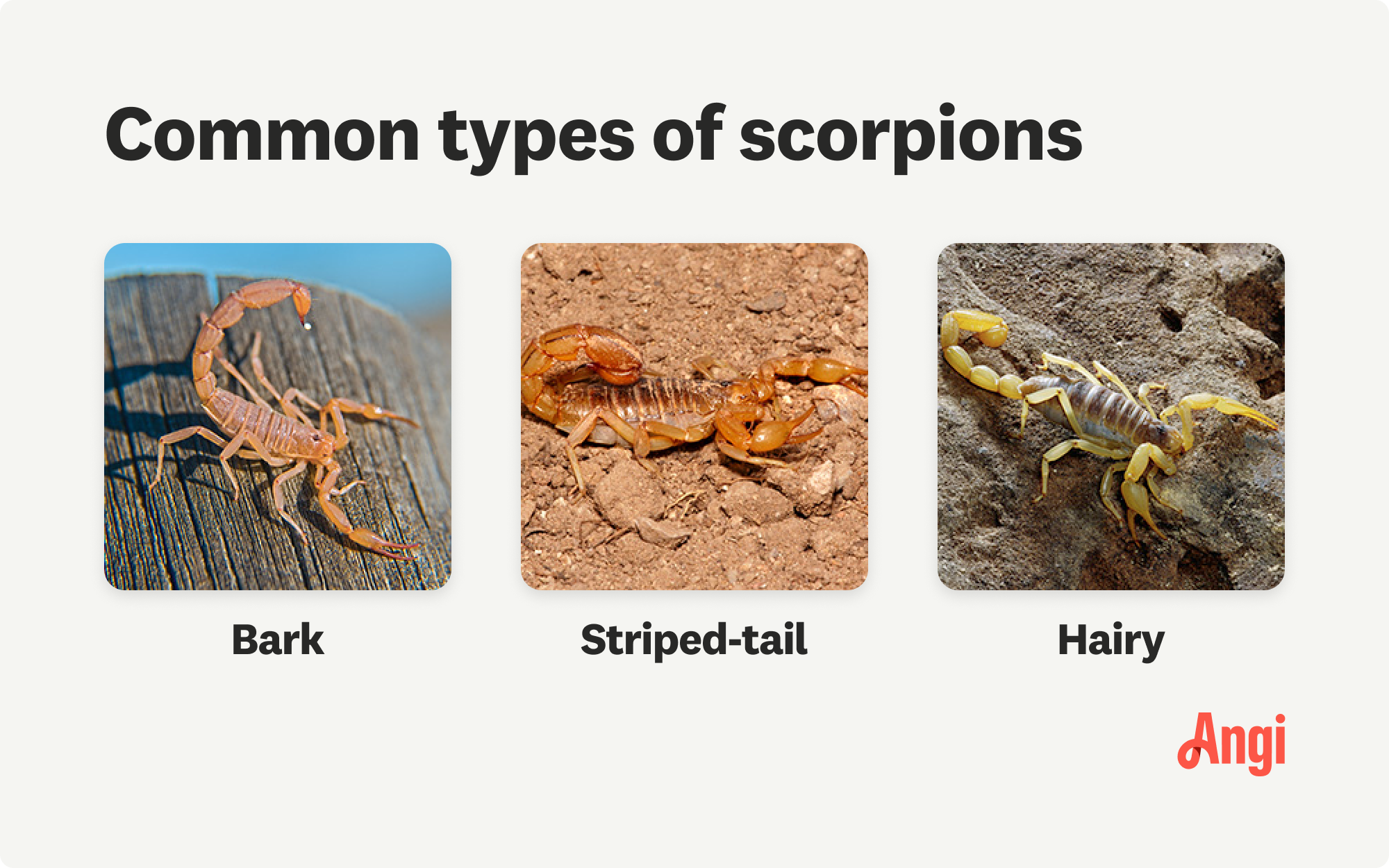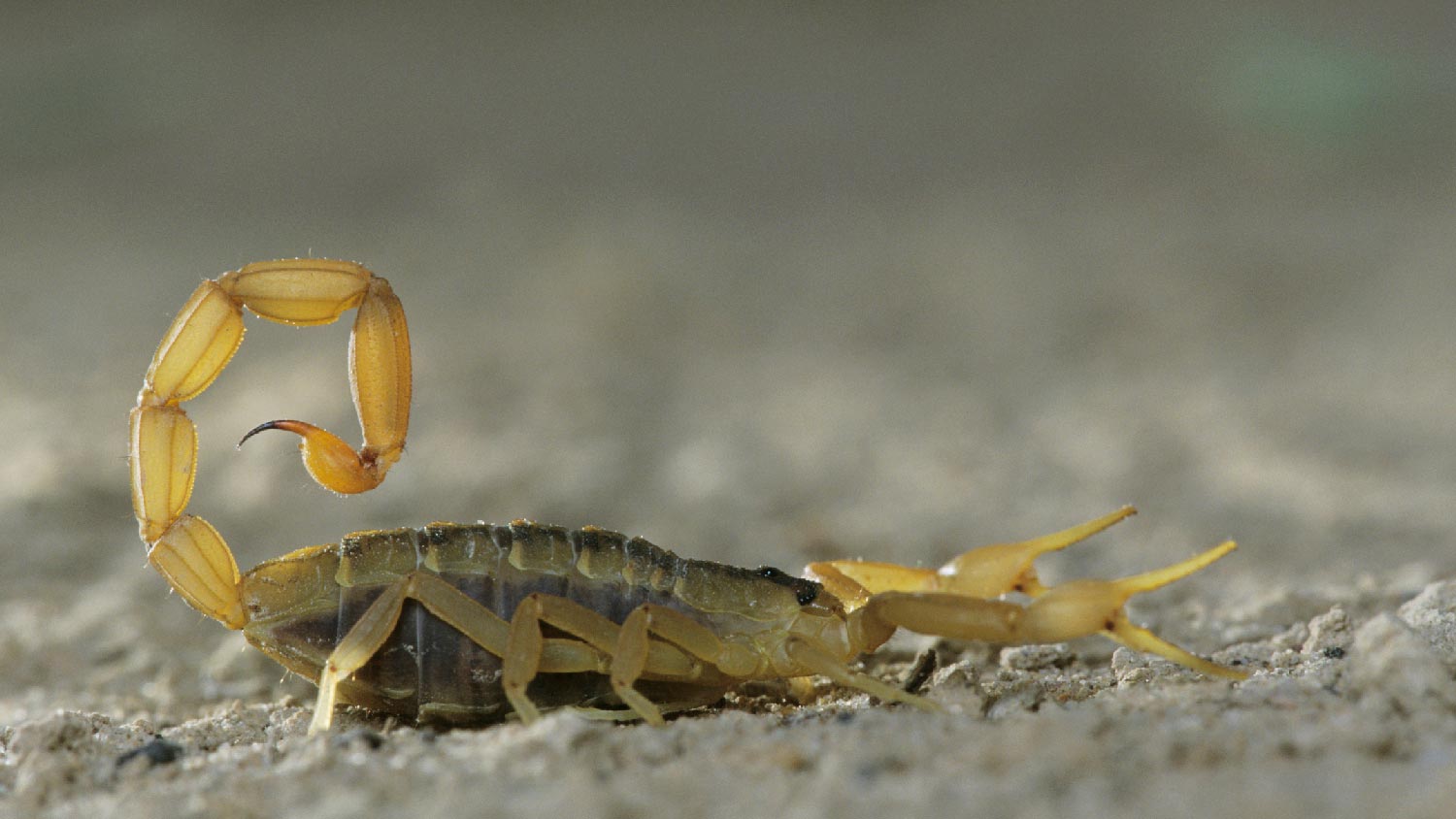
The cost to remove a groundhog can vary depending on where you live and whether you do it yourself or hire a professional. We’ll help you figure out the true cost of groundhog removal, along with strategies for humane trapping and release.
Pinch me, wake me from this nightmare


Although 100 species of scorpions live in the United States, only three species commonly invade homes: bark, striped-tail, and hairy scorpions.
Bark scorpions are yellow in color and have a venomous bite, so you’ll want to work with a pro to remove one.
Striped-tail scorpions are tan to yellow in color, and they are not venomous.
Hairy scorpions are the largest of the three—up to 7 inches—but they are not venomous.
Most species of scorpions are active at night and are attracted to water and damp areas.
Living in a desert climate means dealing with some unusual critters. But, if you live in Arizona, parts of New Mexico, California, or Nevada, you’ll often encounter this nightmare-inducing pest—the scorpion. While most types of scorpions are harmless, one type is venomous, and unfortunately, it’s one of the most prevalent in the U.S. But how do you know if you should be just grossed out or run for the hills? This guide will help you tell the difference between different types of scorpions.

Scorpions are arachnids, closely related to spiders, ticks, and mites. They have a lobster-like appearance with two pincers and eight legs. They also have a long, segmented tail with a distinct stinger, which classifies them as a stinging pest along with bees and wasps. While they have two eyes in the center of their heads and two to five on each side of their body, scorpions rely heavily on their sense of touch as they cannot see well.
There are nearly 2,000 species of scorpions worldwide, but fewer than 100 species live in the United States. Only three commonly invade homes: bark scorpions, striped-tail scorpions, and hairy scorpions.
| Characteristic | Bark Scorpions | Striped-tail Scorpions | Hairy Scorpions |
|---|---|---|---|
| Size | 3 inches | 2 1/2 to 3 inches | 5 to 7 inches |
| Color | Yellow | Yellow to tan | Pale yellow to brown |
| Preferred environment | Damp | Dry | Damp |
| Does it burrow? | No | Yes | Yes |
| Does it climb? | Yes | No | No |
| Venomous bites | Yes | No | No |
Arizona bark scorpions are the ones to watch out for. It’s the most venomous species in North America, and it can cause serious harm to humans. This critter is about three inches long, has a yellow body, and climbs like nobody’s business. If you spot bark scorpions in your home, call local wildlife control to talk about removing them safely.
These scorpions can be identified by their striped tails, and you’ll find them most often burrowing in dry areas. It’s about the same size as a bark scorpion but may be more tan than yellow. While they can still sting you, the striped-tail scorpion’s venom isn’t dangerous.
Hairy scorpions are big—sometimes known as the giant desert hairy scorpion—reaching up to seven inches long. Though they do have “hairs” on their body that differentiate them from other scorpions, if you’re picturing a furry lobster, you’ll be disappointed. The small hairs on its belly, legs, and tail are actually a hunting tool to pick up vibrations in the sand, indicating prey.

Scorpions have a distinct look, and each species has characteristics that can help you identify them.
Different types of scorpions have different hues, but common scorpions tend to be a little on the yellower side: Bark scorpions have a yellow body, striped-tail scorpions range from yellow to tan, and hairy scorpions have a yellow body with a brown top.
The bark scorpion is relatively small, around three inches in length, but is characterized by its extremely thin tail—only around 1/16th of an inch wide. Striped-tailed scorpions have thicker tails but only grow to be around two-and-a-half to three inches long. The largest of the bunch is the hairy scorpion, which can be five to seven inches long.
A good way to tell what kind of scorpion you’re dealing with is by looking for other visual cues. The bark scorpion is the least remarkable, presenting no visual patterns or stripes on its body. The striped-tailed scorpion, living up to its name, has stripes that line the upper side of its body. The hairy scorpion is also identifiable by—you guessed it—hairs covering its body.
Scorpions are nocturnal, solitary creatures that often feed on other invertebrates like insects, spiders, and other types of scorpions—though some larger scorpions will feed on vertebrates like small lizards, snakes, and mice.
Scorpions like to live in warm, dry climates. That’s why you’ll only see scorpions as common pests predominately in Arizona, Nevada, California, and New Mexico.
Most scorpions, like the striped-tail and hairy scorpion, are burrowers, which means they love sandy desert floors and rocky hillsides. Some, like the bark scorpion, don’t burrow but are proficient climbers—with the bark scorpion easily climbing slump block walls or stucco.
Most scorpions, like the bark scorpion and hairy scorpion, are attracted to water, which means you’ll find them in damper areas like cellars, attics, bathrooms, kitchens, swimming pools, and other moist areas where they might find their prey. The striped-tailed scorpion, however, isn’t attracted to water, so you’d find them more under common objects such as sleeping bags, shoes, and other items on the ground.
Scorpions are slow to grow, maturing between one to six years. Some live as little as three years, and others up to 25 years. While there’s some variety in the different types of scorpions, all of them have roughly the same maturity rate and life span.

While all scorpions contain a certain amount of venom, only 25 types of scorpions in the world pose any danger to humans. While the striped-tail scorpion and hairy scorpion aren’t on that list, the bark scorpion can be dangerous to humans.
The first thing you should do if you get stung by a bark scorpion is call your local poison control. Then, clean the area with soap and water, apply a cold compress, and rest it in a secure position above your heart to slow blood flow. You may take pain relievers like ibuprofen to mitigate some of the effects, but you shouldn’t inject anything that’ll make you drowsy.
Scorpions play a large role in controlling the insect populations in desert areas and are an important source of food for larger predators like owls and bats. Also, while all scorpions have venom, not all scorpion venom is dangerous to humans. In fact, researchers have determined that certain types of scorpion venom actually contain some healing properties.
From average costs to expert advice, get all the answers you need to get your job done.

The cost to remove a groundhog can vary depending on where you live and whether you do it yourself or hire a professional. We’ll help you figure out the true cost of groundhog removal, along with strategies for humane trapping and release.

When calculating wildlife removal costs, you’ll need to consider the type, size, and amount of animals. Our guide will show you the wildlife removal cost.

When calculating fox removal costs, factor in whether you take a DIY approach or call in the pros, the number of animals involved, and the location.

Skunks aren’t aggressive, but they emit a noxious, lingering spray when under threat. Learn how to get rid of skunks around your home to avert their aroma.

There are different types of armadillos, with one calling North America home, the Nine-Banded Armadillo. Discover more about these species.

Homeowners should know the key differences between badgers vs. raccoons. Here are their unique traits and impacts on humans.